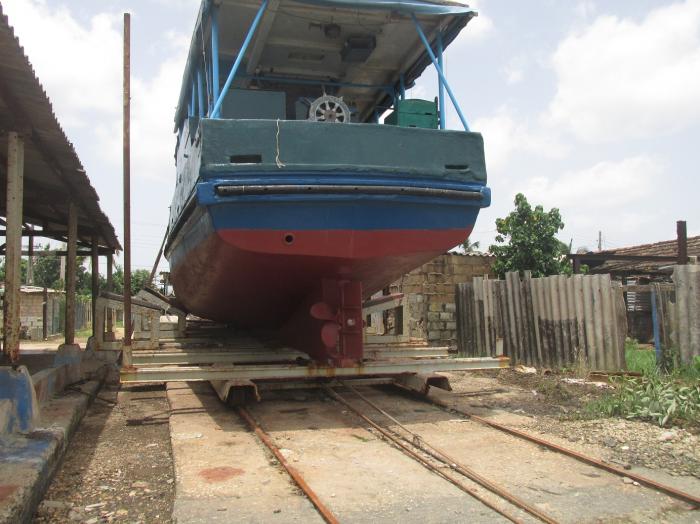
The Júcaro Marine Fishing Fleet UEB stops paying in other ports for stays (Photo: Ortelio)
Pulled by a powerful winch and a thick, resistant steel cable, the ship climbs two rails that sink to the bottom of the sea. The pulley screeches as the hull advances towards the mainland, distills water and reveals itself, rusty and battered for so long at the mercy of the depths.
The men carefully observe the slow rise of the mass of more than 40 tons of weight. The lifting ends in less than half an hour, since the ship rolled through the so-called cradle (on top of which the iron-cement structure rests) and was ready to begin the revision of the axis line, and the live work (keel), to then start the scraping, cleaning and finish with the three paint schemes that the boat has.
The experts also dedicate time to the mechanical explorations of the engine, the upper work (where the crewmembers go), the floor and other details that are always visible on dry land.
If there are no difficulties with the resources, the iron-cement will take about ten or 12 days to go to sea, an operation that in another shipyard would take months, sometimes up to a year and more. Just a one-day stay costs the base business unit (UEB) about 528 pesos.
“Only for that concept we managed to pay more than 47,000 pesos for the repair of a boat, to which are added food and salary expenses, plus round trip fuel. And all without taking a fish out of the sea!” Reinerio Díaz Betancourt, director of the Júcaro Marine Fishing Fleet UEB, says.
Not the slightest trace remains of the painful vestige of what the dry dock was long ago – inactive for more than ten years. The change came with the good work of a group of avant-garde workers, led by Reinerio Díaz.
«I graduated from the Ministry of the Interior and spent a little work to find work. A friendly hand suggested I come here and, after the corresponding procedures, they accepted me and here I am, in my other combat trench.
«You will see that here we will repair all the ships. I even climb a shrimp boat if I put my mind to it”, he asserted with his proverbial snatch of a determined man and with his mind set on registering any marine environment that appears.
"I thought about the shrimp boats, to be able to repair our own boats and not depend on others, but Basilio, the one from the company, told me that it was not all enthusiasm, that I should test the dry dock, certify it, to see if it held to the shrimp fisherman, weighing several tons more than the fish.
«Well, I'll tell you that Basilio told me no; and I, yes; he, no, and I… until he asked me: “Reinerio, what do you do if a ship falls from up there? What are you doing to yourself?”. He repeated the phrase and that was when I seriously thought about the rise. I, with little knowledge of the sea, of ports, of dry docks, thought that even an ocean liner could go up there, but not everything has its laws and its tricks. Luckily, he persuaded me, he stopped me.
“In truth, I believe that a shrimp boat is a lot for the shipyard recovered by ourselves, certified by the Cuban Registry of Ships for the fishing vessels, but not for raising shrimp boats weighing 50 and more tons. That will come sooner than later.
«The repair of the dry dock? –Reinerio Díaz Betancourt continues – it was with its own resources and came into operation after remaining inactive for a decade. In September of last year, we had put into the water eight boats dedicated to the fishing of scale species, with the consequent saving of resources and the reduction of the cost and time for repairs.
«To put it up, he specifies, it was necessary to rehabilitate about a hundred meters of railway lines (a large part of them submerged in water); we also pass our hand to the cradle on which the ship rests; and we manufacture, in the unit itself, the patecas (kind of washers), essential for the proper functioning of the structure».
The most important thing in the history of the slipway and its people is that it has been the backbone of the UEB, with the repair of the entire fleet: ten escamers and seven shrimpers and, according to Alexis Benavent Martínez, director of the Company Pesquera de Ciego de Ávila (Epivila), today the Júcaro UEB is the only one –among its similar ones in Manzanillo, Santa Cruz del Sur and Cienfuegos– that complies with the shrimp capture plan, one of the country's exportable items.
Reinerio Díaz Betancourt, who speaks very quickly, tells the story in just a few minutes; a dialogue on the edge of the boathouse, swallowed by neglect, abandonment and the sea on more than one occasion and now returned by the effort of a group that does not allow itself to be swept away by the current of immobility.




